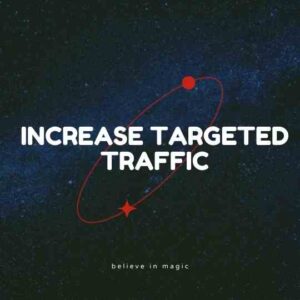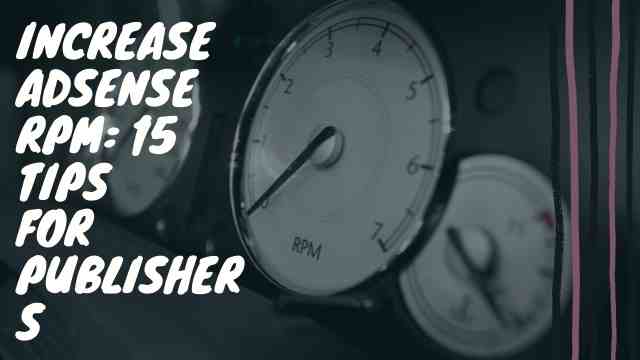Publishers frequently pursue AdSense RPM as one of their major success measures. The shifting nature of RPM as a statistic is a key challenge for publishers in this area. It could soar to great heights one day and then crash to the ground the next.
In general, when it comes to AdSense RPM, any projections are unreliable. As a result, most Google AdSense publishers wonder, “How can I improve AdSense RPM?”
Furthermore, many publishers confuse RPM with CPM, further confounding the situation.
Before we go into techniques for growing RPM in AdSense, it’s important to understand what RPM is and how it differs from CPM.
How To Increase AdSense RPM
When it comes to boosting RPM, there are a variety of approaches to try. We’ve included nineteen different techniques to enhance RPM in this article.
As you read through the list, you’ll realise that all of the points are interconnected, and we recommend that you evaluate all of them in order to achieve better results.
#1 
Getting started with the AdSense RPM gamut requires attracting high-intent, well-targeted traffic. A high volume of relevant traffic will result in the best value CPMs being maintained, resulting in a higher RPM.
Contextual targeting is becoming increasingly significant in the ad tech sector, therefore as a publisher, you should be aware of it.
#2 Strengthen your SEO
Search engine optimization (SEO) focuses on the intent of the search. As a result, SEO should be prioritised for boosting relevant visitors. You can attract high-quality visitors to your website by using search engines, and SEO expertise can help you do so.
#3 Improve content quality score
After you’ve attracted people to your website, the following step is to keep them there. Check to see whether your content or content curation is repelling your visitors. Examine your own site as if you were a user, and see if your content matches the search context perfectly.
#4 Bet on real-value CPC keywords
Following organic, you must invest in paid efforts. Find high-paying CPC keywords that are also relevant to the content on your website. Keyword tools such as Keyword Planner, Ahrefs, and SEMrush can assist you in finding the proper keywords.
#5 Use section targeting
The content is at the centre of everything. Because you’re using content and relevance, the section targeting AdSense feature can help you improve the relevancy of your advertising by giving users more contextual and content-focused ads.
#6 Use geotargeting
When you have a good handle on contextual ads, narrowing down the targeting by geography can be even more effective. Consider narrowing your targeting for this location to gain better impressions. For example, if you know that the US region provides you the most relevant traffic, consider narrowing your targeting for this location.
#7 Use category blocking
If it hasn’t already been stated, ad relevancy and income are inextricably linked. The displayed ad has the potential to generate a large number of impressions. Consider using the blocking section of your AdSense account to put the category on hold if it comes at the cost of an extremely low CPC/CPM.
#8 Excel your user experience
The major goal of your website is to display advertisements. The content, on the other hand, is the main focus of your visitors. As a result, it’s self-evident that adverts should be placed in such a way that they don’t interfere with visitors’ reading experience. Again, visit your own site or seek comments from a peer. Next, consider whether you’re giving the user experience its due. In addition, user experience can help you improve your SEO.
#9 Experiment with ads
The ad formats you select to present, the location where they’ll appear, their closeness to the content, the look of the advertising, and the number of ads you show are all critical factors to consider. All of these aspects contribute to visitors’ understanding of how much they want to engage with your website; more time on site equals higher CPMs. AdSense RPM
#10 Start header bidding
Header bidding is a better alternative to the conventional publisher waterfall method, which involved passing each ad request from one ad network to the next for fill rates, and so on. By allowing you to target several demand partners at the same time, header bidding increases competition for your ad inventory and maintains strong CPMs.
#11 
Creating quality content for your readers is the best approach to obtain more clicks and increase your revenue. You increase your chances of earning clicks by generating traffic. In addition, by drawing visitors, your site becomes more appealing to advertising.
You might be wondering how you can develop outstanding content at this stage. Looking at the blogs that already provide traffic to your site is a good place to start.
#12 Find the Right Keywords for Your Site
You should look at the keywords people use to reach your website in addition to creating engaging content. You may easily enhance your organic traffic by optimising your site for search engines or SEO. AdSense RPM
And more traffic equals more clicks, which means more money for Google AdSense. The MonsterInsights Search Console report can help you figure out what keywords visitors use to locate your website.
#13 Find Out How Far People Scroll Your Website
When it comes to ad placement, the basic guideline is to put your advertising in a highly prominent location of your website where your visitors will be more likely to see them and click on them.
However, how do you know where to post your advertisements?
Checking how far readers scroll through your blog entries is a simple method to find out. You won’t get any clicks if you place your ads where your visitors aren’t browsing, and you’ll lose money as a result.
#14 Follow Ad Placement Best Practices
If you have a WordPress blog, there are a few recommended practises for placement that you should strive to increase your earnings:
Homepage:
Rush App Kya Hai | Rush App से पैसे कैसे कमाए ?
Use the 72890 leaderboard image ad unit above the fold of your homepage and below the main navigation bar to enhance your click-through rate (CTR).
You can also use a vertical ad unit of the same size (72890) in the middle or at the end of the homepage, depending on the length of the page.
In your sidebar, experiment with different ad units, such as a 160×600 skyscraper or a 300×250 medium rectangle.
Page of the blog: AdSense RPM
At the top of your content, place a 336280 huge rectangular ad unit.
Use a comparable ad unit before the comments area at the end of your post.
Place a skyscraper or a medium rectangular ad unit in your sidebar, similar to the homepage.
#15 A/B Test Your Ads Placements
You can also do an A/B test to discover which of these ad placement best practises work best for your website.
You may then determine the locations that increase your Google AdSense RPM earnings based on the outcomes of the tests.
The addon now allows you to perform similar tests at the page level, allowing you to target a specific blog post for better ad placement.
To get the most out of Google Optimize, read our proven strategies post to learn about the many types of trials you may run.
